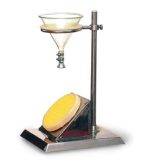Spray Rating Tester

Spray Rating Tester
The Spray Rating Tester is a textile testing instrument used to evaluate the water resistance or water repellency of fabric surfaces. It measures how well a fabric can resist wetting when exposed to a controlled spray of water, helping assess its performance in rain or damp conditions.
Purpose of Spray Rating Tester
– To assess surface wetting resistance of textiles.
– Commonly used for outdoor clothing, rainwear, tents, and performance fabrics.
Working Principle of Spray Rating Tester
– A fabric specimen is mounted at a 45° angle.
– Water is sprayed from a standard nozzle for a specific time.
– After spraying, the fabric is visually rated based on the appearance of water drops and wetting.
Key Components of Spray Rating Tester
– Spray Nozzle: Delivers a consistent, standard water spray.
– Funnel & Reservoir: Controls the flow and volume of water.
– Specimen Holder: Positions the fabric at a 45° angle.
– Spray Stand: Ensures accurate nozzle height and positioning.
Standards Used of Spray Rating Tester
– AATCC 22
– ISO 4920
– BS EN 24920
Applications of Spray Rating Tester
– Rainwear and water-resistant textiles.
– Quality control in fabric finishing.
– R&D for performance apparel.
Benefits of Spray Rating Tester:
- Quick and Simple Evaluation – Offers a fast way to assess fabric water repellency without complex setup.
- Standardized Testing- Complies with AATCC 22 and ISO 4920, ensuring globally accepted results.
- Cost-Effective- Low maintenance and no power requirement make it economical for routine lab use.
- Improves Fabric Performance – Helps manufacturers develop or improve water-resistant textiles.
- Non-Destructive Test – Does not damage the fabric, allowing for additional tests on the same sample.
- Visual Grading- Easy to interpret using a standard spray rating chart (0 to 100 scale).
- Supports Quality Control – Detects finish degradation or variation in water-repellent treatments.
- Portable and Compact- Lightweight design allows easy use in various lab or field settings.
Features of Spray Rating Tester:
- Standardized Spray Nozzle – Delivers consistent water spray per AATCC and ISO specifications.
- 45° Specimen Mounting Angle – Ensures uniform test setup for accurate and repeatable results.
- Stainless Steel or Aluminum Frame – Corrosion-resistant and durable for long-term use with water exposure.
- Water Reservoir and Funnel System – Provides precise water volume (usually 250 ml) for each test.
- Graduated Spray Stand- Fixed height (150 mm above specimen) for controlled spray impact.
- Detachable Specimen Holder- Easy loading and removal of fabric samples.
- Compact and Lightweight Design – Portable and convenient for both lab and field testing.
- No Electricity Required – Fully manual operation increases reliability and reduces operating costs.
How to Use Spray Rating Tester:
- Prepare the Sample – Cut fabric to standard size (usually 180 × 180 mm). – Condition the sample if required (21°C, 65% RH for 24 hours).
- Mount the Fabric – Place the fabric on the specimen holder at a 45° angle.
- Fill the Reservoir – Pour 250 ml of distilled water into the upper funnel.
- Start the Test – Release the water through the nozzle; it sprays over the fabric for about 25–30 seconds.
- Inspect the Fabric – After spraying, visually assess the water beading or penetration on the surface.
- Rate the Sample – Compare the fabric’s wetting pattern with the standard spray rating chart: – 100 = No sticking/wetting – 90–50 = Partial wetting – 0 = Complete wetting
- Record the Rating – Document the spray rating for quality control or reporting.
Spray Rating Tester,
Water Repellency Tester
Spray Reting Tester
[Scope of application]:
Used for the determination of moisture resistance (wetting grade) of various fabrics
which have been or have not been treated with water resistance or water repellency.
[related standards]:
GB/T4745 ISO4920 AATCC22 JISL1092 etc.
[technical parameters]:
1. Glass funnel:150 x 150 (capacity 500ml)
2. Specimen placement angle:The level is 45 degrees.
3. Distance from nozzle to sample center:150mm
4. Specimen diameter:Ф150mm
5. Size of water receiving pan:500×400×30mm
6. Matching measuring cups:500ml
7, size 500 x 400 x 500mm
8. Instrument weight:5Kg



 Products
Products
 Martindale abrasion tester Updated
Martindale abrasion tester Updated









 It is used for testing dynamic and static drape properties
(drape coefficient, shape change rate, surface ripple and drape uniformity, etc.)
of various fabrics.
Related standards GB/T23329 FZ/01045 BS5058 etc.
Instrument characteristics
1. CCD imaging, dynamic and static image processing.
2. A variety of charts and data statistics, analysis, storage, output
3. No need to replace background color, can test all kinds of color samples.
4. Work mode:Microcomputer control, CCD imaging, automatic processing of images and data automatically.
Technical parameters
1. Communication interface: RS232, USB
2. Image sensor: CCD sensor.
3. Static (dynamic) state draping coefficient: 0 ~ 100% + 2
4. Drapability uniformity: 0 ~ 100% + 2
5. The rate of morphological change is 0 to 100% + 2.
6. Surface waviness error: + 1
It is used for testing dynamic and static drape properties
(drape coefficient, shape change rate, surface ripple and drape uniformity, etc.)
of various fabrics.
Related standards GB/T23329 FZ/01045 BS5058 etc.
Instrument characteristics
1. CCD imaging, dynamic and static image processing.
2. A variety of charts and data statistics, analysis, storage, output
3. No need to replace background color, can test all kinds of color samples.
4. Work mode:Microcomputer control, CCD imaging, automatic processing of images and data automatically.
Technical parameters
1. Communication interface: RS232, USB
2. Image sensor: CCD sensor.
3. Static (dynamic) state draping coefficient: 0 ~ 100% + 2
4. Drapability uniformity: 0 ~ 100% + 2
5. The rate of morphological change is 0 to 100% + 2.
6. Surface waviness error: + 1 








